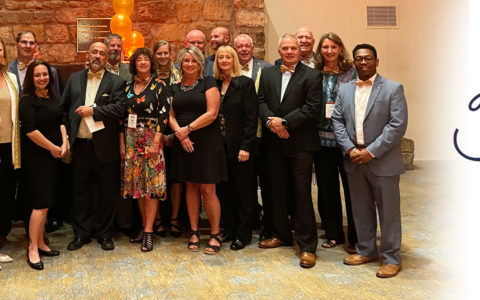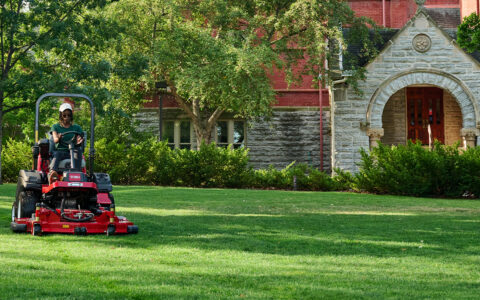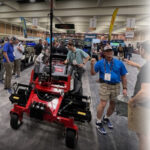Part 2 in a Series on a Groundskeeping Legend
Sometimes it’s not what you know, but who you know and what they know that makes the difference. That’s the kind of serendipity that brought groundskeeping legend George Toma and longtime Toro agronomist Dr. Jim “Doc” Watson together back in 1958. We recently asked Toma to share how he met Watson and how his advice made a difference in Toma’s career.
The Turnaround That Started It All
When Toma started as head groundskeeper at Kansas City’s Municipal Stadium in the fall of 1957, the field was full of weeds and in terrible shape. The next spring, it took about a month for Toma to kill all of those weeds, leaving very little turf behind.
“In those days, people would sell you sod, but it was cow pasture full of weeds,” Toma says. He needed a better option. That’s when Kansas City Toro dealer Tex Champion of Champion Turf asked Toro’s chief agronomist Doc Watson to come visit.
“Around Memorial Day, we seeded with Common Bermuda and it was 35 cents a pound,” Toma recalls. “By the Fourth of July, we were getting raves all over the country. I had only been there six months and I was getting jobs offered to me. The field was like an oasis in the desert — it was so beautiful. Even today, when ballplayers write stories in books, they mention Kansas City Municipal Stadium and how beautiful it was.”
The Secret: Pre-Germination
“In those days we didn’t sod; Doc Watson taught me pre-germination,” Toma explains. “We would take the infield and scarify it, then we would put the pre-germinated seed on it on a Sunday right after the last baseball game. We’d be mowing it Friday, painting the lines Saturday and playing the football game Sunday and never have any problems.”
This was back before Kansas City had Kauffman Stadium and Arrowhead Stadium. Baseball (the then-Kansas City Athletics), football (the Kansas City Chiefs) and soccer (the Kansas City Spurs) were all played on the same field at Municipal Stadium.
“They said we had the best baseball field in baseball, the best football field in football, and [soccer player] Pelé said we had the second-best field he ever played on … only Wembley Stadium was better,” Toma says.
Making Super Bowl History
The field got even more attention when NFL commissioner Pete Rozelle came to Kansas City and held a press conference. “The press asked him, ‘What’s the difference in play between the NFL and the AFL?’ and he said he didn’t see much difference in the play of the game, but he’d never seen such a beautiful, outstanding football field,” Toma remembers.
The day after the press conference, Toma was asked to get the field ready at the Cotton Bowl for the televised 1966 NFL Championship Game between the Dallas Cowboys and the Green Bay Packers — the same field used for the Cotton Bowl just a day before. After that, Toma was asked to prep the field for the first Super Bowl in 1967 at the Los Angeles Coliseum, and he’s continued to do it every year for the last 50 years.
Using Doc Watson’s Expertise
Year after year, Doc Watson came to check the field and help Toma and his crew prepare for the Super Bowl, in addition to many other events. Toma remembers one year the Super Bowl was played in San Diego and the weather was cool — another field he found in rough shape. With Doc Watson’s recommendations, the crew aerified the field and used a Bermuda stolon planter weighted with sandbags to push in the pre-germinated seed.”
After topdressing, Watson had the crew cover the entire field with rolls of 6-mil. plastic and go over it with a pin spiker to punch holes in it. That was on Friday, and by Monday, the grass was two inches high. After that, Watson had the crew cut the plastic down the middle and pull it off between 10 a.m. and 3 p.m. each day. “They called it the Miracle of 28 Days,” Toma says. “It played very well.”
Toma also remembers when his son, Chip Toma, worked with Watson to build two football fields for the Kansas City Chiefs on a limited budget. “They called it the Doc Watson-Chip Toma milkshake,” he laughs. “We put our own drainage in and we put our own irrigation in. But the soil was clay. We sent a sample down to Texas A&M, and they said with this blend of soil, you need 15 inches of sand. We only had enough money for 5 inches of sand, so after we put our own drainage in, Doc Watson had us put a few inches of sand down, then rototill it up to about an inch of dirt. Then we rotary-harrowed and sprigged it. It was a great field. It rained the first day of Chiefs practice 4.75 inches, and we had no problems with 120 players. The grass was there all year with three sports using it, and high school championships, too.”
Looking Back
Toma gives Doc Watson a lot of credit for his success over the years. “If it wasn’t for Doc Watson, I wouldn’t be here today. He took me under his wing,” Toma concludes. “I’m 87 years old. I’ve been in this game for 75 years, and I’ve never met a man in the turf business like Doc Watson. He’d tell it like it is. He gave it to you in black and white, and he was there to help you. With Doc Watson and our pre-germinated seed, we had better fields than the fields that are sodded today. He was in charge for all 1994 World Cup venues and had excellent fields. We needed him for the COPA games this year!”
Super Bowl is a registered trademark of the NFL.














